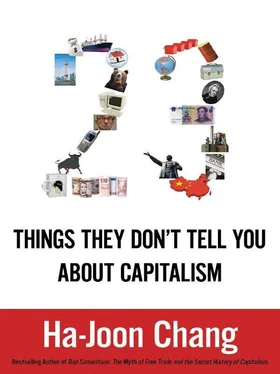Germany is not the only country that has experienced hyperinflation. In the financial press Argentina has become a byword for hyperinflation in modern times, but the highest rate of inflation it experienced was only around 20,000 per cent. Worse than the German one was the Hungarian inflation right after the Second World War and that in Zimbabwe in 2008 in the last days of President Robert Mugabe’s dictatorship (now he shares power with the former opposition).
Hyperinflation undermines the very basis of capitalism, by turning market prices into meaningless noises. At the height of the Hungarian inflation in 1946, prices doubled every fifteen hours, while prices doubled every four days in the worst days of the German hyperinflation of 1923. Price signals should not be absolute guides, as I argue throughout this book, but it is impossible to have a decent economy when prices rise at such rates. Moreover, hyperinflation is often the result or the cause of political disasters, such as Adolf Hitler or Robert Mugabe. It is totally understandable why people desperately want to avoid hyperinflation.
However, not all inflation is hyperinflation. Of course, there are people who fear that any inflation, if left alone, would escalate into a hyperinflation. For example, in the early 2000s, Mr Masaru Hayami, the governor of the central bank of Japan, famously refused to ease money supply on the ground that he was worried about the possibility of a hyperinflation – despite the fact that his country was at the time actually in the middle of a deflation (falling prices). But there is actually no evidence that this is inevitable – or even likely. No one would argue that hyperinflation is desirable, or even acceptable, but it is highly questionable whether all inflation is a bad thing, whatever the rate is.
Since the 1980s, free-market economists have managed to convince the rest of the world that economic stability, which they define as very low (ideally zero) inflation, should be attained at all costs, since inflation is bad for the economy. The target inflation rate they recommended has been something like 1–3 per cent, as suggested by Stanley Fischer, a former economics professor at MIT and the chief economist of the IMF between 1994 and 2001. [16] S. Fischer, ‘Maintaining price stability’, Finance and Development , December 1996.
However, there is actually no evidence that, at low levels, inflation is bad for the economy. For example, even studies done by some free-market economists associated with institutions such as the University of Chicago or the IMF suggest that, below 8–10 per cent, inflation has no relationship with a country’s economic growth rate. [17] A study by Robert Barro, a leading free-market economist, concludes that moderate inflation (10–20 per cent) has low negative effects on growth, and that, below 10 per cent, inflation has no effect at all. See R. Barro, ‘Inflation and growth’, Review of Federal Reserve Bank of St Louis , 1996, vol. 78, no. 3. A study by Michael Sarel, an IMF economist, estimates that below 8 per cent inflation has little impact on growth – if anything, he points out, the relationship is positive below that level – that is, inflation helps rather than hinders growth. See M. Sarel, ‘Non-linear effects of inflation on economic growth’, IMF Staff Papers , 1996, vol. 43, March.
Some other studies would even put the threshold higher – 20 per cent or even 40 per cent. [18] See: M. Bruno, ‘Does inflation really lower growth?’, Finance and Development , 1995, vol. 32, pp. 35–8; M. Bruno and W. Easterly, ‘Inflation and growth: In search of a stable relationship’, Review of Federal Reserve Bank of St Louis , 1996, vol. 78, no. 3.
The experiences of individual countries also suggest that fairly high inflation is compatible with rapid economic growth. During the 1960s and 70s, Brazil had an average inflation rate of 42 per cent but was one of the fastest-growing economies in the world, with its per capita income growing at 4.5 per cent a year. During the same period, per capita income in South Korea was growing at 7 per cent per year, despite having an annual average rate of inflation of nearly 20 per cent, which was actually higher than that found in many Latin American countries at the time. [19] In the 1960s, Korea’s inflation rate was much higher than that of five Latin American countries (Venezuela, Bolivia, Mexico, Peru and Colombia) and not much lower than that of Argentina. In the 1970s, the Korean inflation rate was higher than that found in Venezuela, Ecuador and Mexico, and not much lower than that of Colombia and Bolivia. The information is from A. Singh, ‘How did East Asia grow so fast? – Slow progress towards an analytical consensus’, 1995, UNCTAD Discussion Paper, no. 97, table 8.
Moreover, there is evidence that excessive anti-inflationary policies can actually be harmful for the economy. Since 1996, when Brazil – having gone through a traumatic phase of rapid inflation, although not quite of hyperinflationary magnitude – started to control inflation by raising real interest rates (nominal interest rates minus the rate of inflation) to some of the highest levels in the world (10–12 per cent per year), its inflation fell to 7.1 per cent per year but its economic growth also suffered, with a per capita income growth rate of only 1.3 per cent per year. South Africa has also had a similar experience since 1994, when it started giving inflation control top priority and jacked up interest rates to the Brazilian levels mentioned above.
Why is this? It is because the policies that are aimed to reduce inflation actually reduce investment and thus economic growth, if taken too far. Free-market economists often try to justify their highly hawkish attitude towards inflation by arguing that economic stability encourages savings and investment, which in turn encourage economic growth. So, in trying to argue that macroeconomic stability, defined in terms of low inflation, was a key factor in the rapid growth of the East Asian economies (a proposition that does not actually apply to South Korea, as seen above), the World Bank argues in its 1993 report: ‘Macroeconomic stability encourages long-term planning and private investment and, through its impact on real interest rates and the real value of financial assets, helped to increase financial savings.’ However, the truth of the matter is that policies that are needed to bring down inflation to a very low – low single-digit – level discourage investment.
Real interest rates of 8, 10 or 12 per cent mean that potential investors would not find non-financial investments attractive, as few such investments bring profit rates higher than 7 per cent. [20] There are many different ways to calculate profit rates, but the relevant concept here is returns on assets. According to S. Claessens, S. Djankov and L. Lang, ‘Corporate growth, financing, and risks in the decades before East Asia’s financial crisis’, 1998, Policy Research Working Paper, no. 2017, World Bank, Washington, DC, fig. 1, the returns on assets in forty-six developed and developing countries during 1988–96 ranged between 3.3 per cent (Austria) and 9.8 per cent (Thailand). The ratio ranged between 4 per cent and 7 per cent in forty of the forty-six countries; it was below 4 per cent in three countries and above 7 per cent in three countries. Another World Bank study puts the average profit rate for non-financial firms in ‘emerging market’ economies (middle-income countries) during the 1990s (1992–2001) at an even lower level of 3.1 per cent (net income/assets). See S. Mohapatra, D. Ratha and P. Suttle, ‘Corporate financing patterns and performance in emerging markets’, mimeo., March 2003,World Bank, Washington, DC.
In this case, the only profitable investment is in high-risk, high-return financial assets. Even though financial investments can drive growth for a while, such growth cannot be sustained, as those investments have to be ultimately backed up by viable long-term investments in real sector activities, as so vividly shown by the 2008 financial crisis ( see Thing 22 ).
Читать дальше






![Ally Carter - [Gallagher Girls 01] I'd Tell You I Love You But Then I'd Have to Kill You](/books/262179/ally-carter-gallagher-girls-01-i-d-tell-you-i-lo-thumb.webp)





